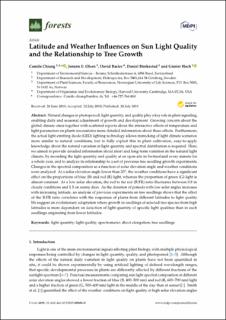| dc.description.abstract | Abstract: Natural changes in photoperiod, light quantity, and quality play a key role in plant signaling, enabling daily and seasonal adjustment of growth and development. Growing concern about the global climate crisis together with scattered reports about the interactive effects of temperature and light parameters on plants necessitates more detailed information about these effects. Furthermore, the actual light emitting diode (LED) lighting technology allows mimicking of light climate scenarios
more similar to natural conditions, but to fully exploit this in plant cultivation, easy-to-apply knowledge about the natural variation in light quantity and spectral distribution is required. Here, we aimed to provide detailed information about short and long-term variation in the natural light climate, by recording the light quantity and quality at an open site in Switzerland every minute for a whole year, and to analyze its relationship to a set of previous tree seedling growth experiments. Changes in the spectral composition as a function of solar elevation angle and weather conditions were analyzed. At a solar elevation angle lower than 20◦ , the weather conditions have a significant
effect on the proportions of blue (B) and red (R) light, whereas the proportion of green (G) light is almost constant. At a low solar elevation, the red to far red (R:FR) ratio fluctuates between 0.8 in cloudy conditions and 1.3 on sunny days. As the duration of periods with low solar angles increases with increasing latitude, an analysis of previous experiments on tree seedlings shows that the effect of the R:FR ratio correlates with the responses of plants from different latitudes to light quality. We suggest an evolutionary adaptation where growth in seedlings of selected tree species from high latitudes is more dependent on detection of light quantity of specific light qualities than in such seedlings originating from lower latitudes. | en_US |

